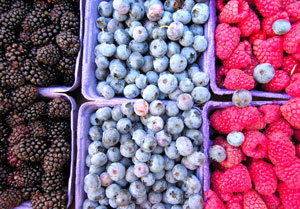 While much attention is paid to the environmental benefits of organic produce, the local food movement is starting to also make real headway. No matter how your food is grown, if it’s shipped from across the U.S. or even from another country, that’s a long way for your food to travel.
While much attention is paid to the environmental benefits of organic produce, the local food movement is starting to also make real headway. No matter how your food is grown, if it’s shipped from across the U.S. or even from another country, that’s a long way for your food to travel.
Locally grown foods are fresher because they don’t have to be picked before they’re ripe for shipping, and are less likely to be subjected to different means of preserving freshness. Many fruits and vegetables must stay in refrigerated trucks, which increases the amount of energy the trucks consume.
While there are some extreme locavores out there, introducing more local food into your diet isn’t as hard as it seems. Plus, eating locally puts more emphasis on eating fresh, non-processed foods that will benefit anyone trying to lose weight. When you eat locally, you’re also supporting the local economy. Here are a few simple ways to eat local.
Shop the Farmers Market
Farmers markets are a great way to get your food fresh from the farm. According to the United States Department of Agriculture, there are at least 6,132 farmers markets operating in the U.S., a 16 percent increase over the past year. You can find one near you at their Farmer’s Market Search.
Ask the Grocer
Ask the store manager about produce and other products that are locally sourced. If you can’t find someone in the store, consider calling. If the grocery store employees don’t know, the food probably doesn’t come from anywhere nearby.
Join a CSA
CSA stands for Community Supported Agriculture, and is another way to get fresh produce directly from your farmer. You essentially buy a “share” in a farm, and they will deliver you fresh produce as its harvested. Different CSAs have slightly different systems, some will deliver food each week and use a bi-weekly schedule.
Reconnect with the Seasons
Part of eating locally will automatically mean you’re eating more seasonally too. Do you really need to eat spring asparagus all winter? Eating foods in season can make these foods feel special again. Do a little research, and be adventurous.
Find a Farm
Wouldn’t it be nice to see where your food really comes from? This is particularly good if you want to see how livestock are being treated. Even if you live in an urban area, the nearest farm may be closer than you think. Look for a farm that offers U-Pick and plan a fun outing that even your kids can enjoy.
Frequent Locally Owned Food Producers
Restaurants, bakeries and even grocery stores are often proud of supporting local agriculture. This is also a good way to find some prepared foods made from locally produced ingredients, like bread, cheese and yogurt.
Grow Your Own
What could be fresher than food grown in your own backyard? Planting a vegetable and herb garden can be rewarding and cost-effective. Consider putting a small planter of herbs in a sunny spot in your house. If you live in a city and don’t have yard space, you can get a plot in a community garden. Also, don’t miss this guide to growing a garden indoors.
Preserve and Store
If you like to cook, pickling and drying can be a fun way to preserve fall and summer produce for the winter. Consider making your own applesauce or stewed tomatoes and storing them in jars to enjoy later.
Be Reasonable
Local food has many benefits, but we can’t deny that we live in an intensely interconnected global economy. Eating locally should enhance, not compromise your nutrition. If you have the option, try to buy Fair Trade products for things that aren’t grown in the U.S., like tea, coffee and chocolate.
Also Read:
Walmart to Sell More Local Produce
Biggest Loser Danny Cahill: Visit Your Farmer’s Market
